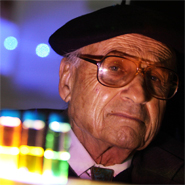Posted 15 October 2009
Irish scientists and industry team up to create new energy technologies
Nobel Prize-Winning Scientist and Advocate for Solar Energy Launches New Nanovation Laboratories at UCD
New scientific laboratories to support the research and development of new energy technologies were officially opened at University College Dublin by Nobel Prize-winning scientist Walter Kohn. Using the facilities, scientists and industry will work together to develop nanotechnologies and products targeted at the global renewable energy market worth an estimated €113 billion by 2015.
Nanotechnology involves the study and use of materials on an unimaginably small scale. Nano refers to a nanometre (nm). One nanometre is a millionth of a millimetre or about one eighty thousandth the width of a human hair.
“At this scale, materials can behave very differently from when they are in larger form. Nanomaterials can be stronger or lighter, or conduct heat or electricity in a different way. By finding out more about the nanoscale world, scientists aim to use nanotechnologies to create new devices that are faster, lighter, stronger or more efficient,” says Professor Nick Quirke, Head of the UCD College of Engineering, Mathematical, and Physical Sciences.
Nobel prize-winning scientist Walter Kohn, who officially launched the new facilities, is one of the world’s leading scientific figures in the search for ways to harness the sun’s energy. He was awarded the Nobel Prize in Chemistry in 1998 for his seminal work on the electronic structure of materials.
According to Professor Kohn, solar energy is a major part of the solution to the provision of future energy needs. He believes it offers an economically realistic, clean and safe energy source to help replace diminishing fossil fuels. “Solar energy is quite realistically estimated, in two or three decades, to contribute perhaps something in the vicinity of 25% of total electricity consumption,” he says.
“The development of new solar energy devices for electricity and for production of green fuels such as hydrogen is one of the major aims of the new laboratories,” says Professor Quirke.
“Multinational companies, SMEs and start ups, who want to develop and test new energy technologies can come to UCD and work with our scientists in the UCD Nanovation Laboratories. The unique combination of imaging, experiment, and theory, offered by the new laboratories also supports potential advances in medicine and medical technology.”
Nanotechnologies are seen as having major potential in area like energy storage, healthcare, and IT. Across the world, governments and businesses have begun to heavily invest in the development of nanotechnologies.
The UCD Nanovation Laboratories were funded by Science Foundation Ireland and the Higher Education Authority to the tune of €3.4 million. Over 30 scientists and 120 PhDs and post Docs conduct research in the laboratories which measure more than 630 square metres.
The official opening event is part of Innovation Dublin 2009 - a week long festival of events to showcase, highlight, promote and encourage innovation and creativity in Dublin which runs from 14-20 October. The aim of the week is to raise public awareness of the innovation and creativity that is happening on a daily basis in Dublin, to inspire and stimulate innovation and creativity and to encourage networking opportunities.
Professor Walter Kohn and the Power of the Sun documentary (2005)
As fossil fuels run out, the search for renewable sources of energy becomes more urgent. The documentary “The Power of the Sun” is about the discovery of the power of light, the genesis of solar energy technologies and their vast and promising potential. It begins with the findings of Isaac Newton and other early scientific visionaries, and moves to the groundbreaking work in 1905 of Albert Einstein on photons, and then on to the work at Bell Laboratories in the 1950s where the first silicon solar cell was produced.
“The Power of the Sun” gives us insight into the clean logic of solar energy, its efficiency and many applications. Executive Producer Professor Walter Kohn, UCSB Nobel Laureate, worked with director/writer David Kennard and others to construct this optimistic and timely presentation. John Cleese serves as host and narrator, helping make the material accessible for all audiences.
There is a 20-minute animated educational film for 12th grade High School students, or freshman College/University students with interests in physics and/or chemistry, materials science, engineering. And there is a 56-minute film, telling the story of photovoltaics -Light; History and Science; Implementation; and Future. It is designed for general public with interest in science, its history and its current and future applications to the world’s energy needs, as well as for policy-makers and opinion leaders in the field of energy.

